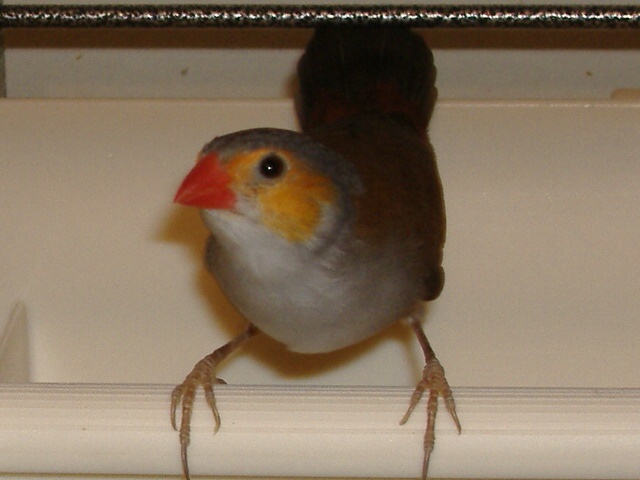Orange-Cheeked Waxbill
From Wikipedia, the free encyclopedia
Order: Passeriformes
Family: Estrildidae
[Photo] Orange-cheeked Waxbill (Estrilda melpoda). Source: Flickr (www.flickr.com/photos/21859273@N07/2117351747/). Date: Taken on September 11, 2005. Author: hartandrew12 (www.flickr.com/photos/21859273@N07/).
The Orange-cheeked Waxbill Estrilda melpoda is a common species of estrildid finch native to western and central Africa, with an estimated global extent of occurrence of 3,600,000 km².
Lifestyle
Lives in small family parties or flocks of thirty of more individuals. Their high-pitched "peeps" are the best clue of their presence. Like most estridids, they are very acrobatic in their movements on twigs and grass stems, "climbing" up and down verticals and hanging upside down while feeding. Males usually have brighter orange patches on the abdomen.
Diet
They feed on tiny grass seeds, which they collect from the ground or, more often, directly from grass panicles. They hang on the stems and harvest the ripe or green seeds, sometimes while hanging upside down. Small insects such as termites, aphids, and gnats are taken during the breeding season.
Reproduction
This species prefers to nest close to or directly on the ground in tangled clumps of tall grass. They will collect the surrounding grass stems together, especially old seed heads (panicles), helping to camouflage the structure. Fine white feathers line the interior where 3-6 tiny white eggs will be incubated for 13 days. Fledglings leave the nest around 23 days looking similar to their parents but sporting duller orange ear coverts for the first few months.
Origin
Originating in Western Africa, they will be found in open grassland with light tree and/or shrub coverage, also along watercourses, in gardens and cultivated fields. They are also commonly found in dry savanna habitats of Angola, Benin, Bermuda, Burkina Faso, Burundi, Cameroon, Central African Republic, Chad, the Republic of Congo, C??te d'Ivoire, the Democratic Republic of the Congo, Equatorial Guinea, Gabon, Gambia, Ghana, Guinea, Guinea-Bissau, Liberia, Mali, Mauritania, Niger, Nigeria, Puerto Rico, Rwanda, Senegal, Sierra Leone, Togo, and Zambia. It also can be found at subtropical/ tropical (lowland) wet shrubland habitats. The status of the species is evaluated as Least Concern. It is introduced on Puerto Rico (United States).
Captivity
Habitat
Orange cheeks like a lot of grass. They eat the seed heads, they forage at its roots for tiny insects, and build their nests directly in it. Some open tall shrubbery and dead, scraggly branches should be provided for roosting. The floor should be composed of a good, dry substrate. Otherwise, the enclosure should have stands of clump and/or runner grasses and reeds which grow 40 cm or taller. Care should be taken to establish walkways through the grass for maintaining the habitat so nests will not be stepped on.
Diet
Small green and ripe millets form the primary seed diet. They usually harvest these directly from the ripening heads; placing bundles of gathered seeding grasses in the enclosure not only adds to the enjoyment of the keeper but helps provide variety in the diet as well. Any species growing locally is acceptable; be sure to collect from sources free of contaminants such as pesticides. They enjoy spray millet and fresh fruits and vegetables as well.
Additionally, small mealworms, fruit flies, and pinhead crickets (which some will take and others will not) should be offered, especially during breeding. Some pairs will learn to take soft food substitutes, others will not but most will raise young on seed alone, if no other offerings are made. A gentle species, they will be easily bullied at the feeding station if only one is provided and they share their enclosure with more aggressive species.
Breeding
Orange cheeks will nest in colonies or as single pairs. As noted, they usually prefer a location in a dense clump of grass or other very low vegetative growth. Nests may even be placed directly on the ground, which is why it should be kept as dry as possible. This location also begs invasion by vermin such as mice and rats, so rodent control is imperative. A feather pillow provides a good supply of fine feathers for lining.
Banding the parents is advisable as the young color out quickly-usually within a few weeks of fledging-and after several nests are raised in a season, you may not be able to tell the parents from their young. Where more than one breeding pair are in an enclosure, banding the young is also necessary if in breeding is to be avoided. Young males may not show their brighter shades of orange until about 6 months of age.
http://en.wikipedia.org/wiki/Orange-cheeked_Waxbill
| The text in this page is based on the copyrighted Wikipedia article shown in above URL. It is used under the GNU Free Documentation License. You may redistribute it, verbatim or modified, providing that you comply with the terms of the GFDL. |
|

